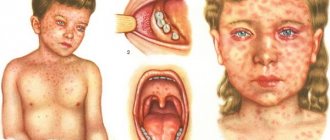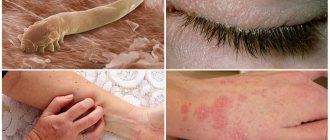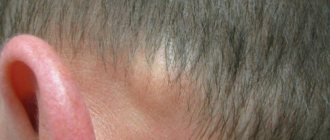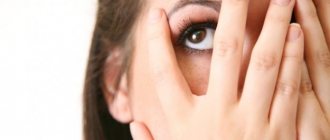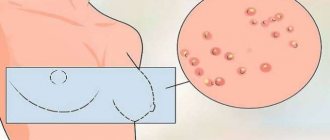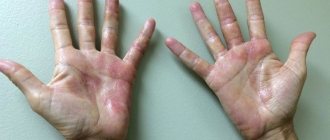Conservative methods of therapy
Drug treatment is aimed at maintaining healthy vision.
First, dry eye syndrome is eliminated. For this purpose, drops “Oxycal”, “Vidisik”, “Quainax” and others are used. Drops must be placed into the eyes in the morning and evening. They help soften the mucous membrane of the eyes and protect them from adverse external influences. Such preparations contain boric acid, so they do not have an irritating effect, and allergies do not occur when using them.
If there is inflammation in the organs of vision, the doctor prescribes antiseptics and antibacterial drugs, these can be, for example, antibiotics such as Garazon or Vitabact, and anti-inflammatory drugs such as Hydrocortisol, Tobradex.
Vitamin complexes and antihistamines may also be prescribed.
The course of therapy is up to one month. The doctor individually selects the dosage of medications and the duration of treatment. During the treatment process, the patient is under the supervision of the attending physician, as control over the course of the disease is necessary.
Diagnostics
The effectiveness of treatment depends on a correctly established diagnosis. The doctor conducts a detailed survey and clarifies complaints. The person must tell why the bubble appeared in the eye or on the eyelid, how quickly it grows, and what sensations it is accompanied by.
Then the doctor examines the eyelids, eyes, and assesses the condition of the fundus at the slit lamp. An ophthalmologist may prescribe laboratory and instrumental examinations:
- CBC to assess the general condition of the body.
- ELISA for detecting viruses.
- Cytological examination of scrapings to evaluate cell characteristics.
- Histological examination of removed elements to exclude oncology.
If the cause of blistering rashes is allergic, it is necessary to identify and exclude the allergen. For this, the person is referred to an allergist.
Before starting treatment, the doctor must identify the exact cause of the formations. After an initial examination by an ophthalmologist, the patient should receive a referral for the following studies:
- biochemical and general blood test;
- microbiological smear;
- instrumental examination of the eye;
- MRI, CT and ultrasound of the visual organs.
In advanced cases, additional consultation will be required:
- oncologist;
- dermatologist;
- gastroenterologist;
- endocrinologist.
If there is an infection in the body, the patient should consult an infectious disease specialist.
What measures to take
- The very first thing to do is contact an ophthalmologist. The accuracy of the established diagnosis directly affects the quality of treatment.
- Compliance with personal hygiene rules: careful washing, individual face towel.
- Do not rub your eyes to prevent mechanical damage, do not remove tumors yourself. This may lead to a worsening of the disease.
- Do not use low-quality cosmetics.
- In case of allergic etiology, avoid exposure of the body to allergens: diet excluding food products that cause allergies; contact with pets if you are allergic to wool; chemicals, etc.
What to do and how to treat
Medicines
Herpetic manifestations can be eliminated with Actipol. When a blister has formed inside the eye, you should contact an ophthalmologist who will conduct a comprehensive examination and prescribe the necessary therapeutic measures. It is often possible to eliminate pathological balls using eye drops, ointments and systemic medications. Considering the cause of blisters in the eyelid area, the following medications are prescribed as presented in the table.
| Deviation | Group of drugs | Name |
| Ophthalmoherpes | Local antiviral agents | "Acyclovir" |
| Eye drops | "Poludan" | |
| "Ophthalmoferon" | ||
| "Aktipol" | ||
| Immunostimulants | "Immunoglobulin" | |
| "Methotrexate" | ||
| Allergy | Antihistamines | "Diazolin" |
| "Suprastin" | ||
| "Claridol" | ||
| "Trexil" |
Papillomas can be easily removed with a laser beam. If a person encounters a lower blister due to papillomavirus, it is necessary to perform laser treatment or eliminate the pathology through surgical excision of the tumor. When the problem is caused by a Moll cyst, no special treatment is required, since small formations will soon go away on their own. If the deviation worsens and the tumor increases, a small puncture is made through which the internal fluid is pumped out.
Are folk remedies effective?
If bubbles appear on the eyelid, it is allowed to use natural ingredients. Such remedies are effective in the early stages, when the blister is still small. Rowan juice, which is used to lubricate the formations, helps to cope with the problem. Aloe juice and banana peels, which are used to wipe the tumor, are no less effective. It is also recommended to prepare decoctions based on the inflorescences of chamomile, lungwort, arnica and other plants. Before using alternative therapy, you must consult a doctor so as not to provoke adverse reactions and complications of the pathology.
What not to do with such blisters
If a blister occurs in the corner of the eye, the following important rules should be followed:
- You should not scratch the blister inside the eye, because such actions can damage the skin and cause a serious infection;
- It is recommended to avoid drafts and cool rooms;
- You should protect yourself from getting dust and dirt on your skin;
- it is necessary to protect affected areas from water;
- avoid stuffy rooms;
- If traditional medicine does not give a positive result, then you can turn to drug treatment.
First aid for blisters in the corner of the eye
When a disease is detected, the patient is advised to first determine what disease he is dealing with. Afterwards, it is recommended to immediately provide first aid, which will become the initial platform for further treatment of the disease.
When outdoors, it is recommended to cover the affected areas with adhesive tape, this way the likelihood of dirt getting into your eyes will be reduced several times.
Important! If dirt gets into the eye, you should immediately rinse the eye with clean warm water. It is recommended to do everything very carefully so as not to damage the blister.
How to care for blisters on the upper eyelid
Each person chooses their own method of caring for emerging blisters. For care, expensive medications or the most common traditional medicine can be chosen.
To reduce swelling of the eyes, apply a decoction of herbs or seaweed to the affected area.
Should you scratch blisters or not?
Blisters that appear in the eye area are often accompanied by severe itching. In this case, many people ask the question: is it possible to scratch them? The answer is quite simple - you can’t.
Scratching the affected area can lead not only to the spread of the disease, but also to an increase in the affected areas and to slower healing.
What are white blisters that appear on the eye, watch in this video:
Treatment methods
It has already been said above that if bubbles are detected in any area of the visual organs, it is highly not recommended to engage in self-diagnosis and self-medication. You should immediately go to the doctor, get examined and begin adequate treatment with appropriate methods. Taking into account the range of various ophthalmic drugs in pharmacies and the use of modern techniques, today it is possible to get rid of almost any misfortune in a few days - subject to a professional approach and a responsible attitude of the patient to treatment.
Local anti-allergenic agents help to quickly cope with discomfort, but they are prescribed strictly by an ophthalmologist together with an allergist
Treatment for blisters on the eyes will depend on the reason why they formed:
In case of allergies, it is important to identify the irritant and eliminate it, then the doctor will prescribe a course of systemic antihistamines and ointments or drops for topical use. You will also need to replace all cosmetic and hygiene products with new ones and adjust your diet - potential allergens such as citrus fruits, chocolate, seafood should be excluded
Herpes is treated only with special antiherpes drugs of local and systemic action. Additionally, immunomodulators are prescribed. If the virus recurs frequently, your doctor may recommend antiherpes vaccination. Moll cysts in most cases resolve on their own, a few days after their appearance. But sometimes they reach very large sizes, cause serious discomfort to the patient, and impair vision. In this case, the doctor carefully punctures the cyst and cleans it out. After this, for prevention, you need to inject antibacterial drugs into the eye for several days. Papilloma can only be treated surgically. They are cut off with special tools or removed with a laser.
Traditional medicine, of course, also did not stand aside, and offers its own methods of treating blisters and papillomas on the eyelids and mucous membranes. It is not recommended to use them independently, without the approval of a doctor, since many compounds can cause severe irritation of the mucous membranes and even burns.
Banana peel is a newfangled folk remedy against papillomas and rashes on the skin and mucous membranes of the eyes.
Things to try:
- Rowan juice against papillomas. The method of application is extremely simple: you need to mash the red berry and lubricate the formations with the resulting pulp. This should be done several times a day until the growths completely disappear.
- Aloe juice. Agave can be used in two ways. The easiest way is to lubricate the blisters and growths with aloe juice several times a day. Or you can stick pieces with pulp to the formations overnight with a band-aid.
- Banana peel. Recently, the method of treating growths with banana peel has become very popular. The formations are rubbed with fruit skins until they completely disappear.
Factors for cyst development
Bubbles formed on the eyelids are not harmful to health, but at the same time they bring a lot of trouble. They provoke the development of itching and irritation. There remains a feeling of the presence of foreign objects in the organs of vision. What influences the formation of bubbles?
The main reason is disruption of the sweat gland of the eyelid. A cyst can be caused by:
- herpes;
- allergic reactions;
- papilloma virus;
- unsuitable cosmetics.
Herpes is found in a person’s blood and, under favorable conditions, comes out in the form of rashes. Infection with the virus threatens the impossibility of its complete cure. It simply cannot be removed, and no treatment will help. Moments of the acute course of herpetic disease are characterized by inflammation of the mucous membranes with the appearance of vesicular neoplasms.
The papilloma virus can cause blisters on the eyelids. It is a neoplasm that looks like small growths. They can appear not only on the eyelids, but also in the lips, armpits and groin. It is extremely rare that bubbles appear due to the use of low-quality or unsuitable cosmetics. New growths are temporary and similar to an ordinary allergic reaction. Changing your usual cosmetic products should solve the problem.
Afterwards, appropriate tests are taken to determine the presence or absence of the virus in the body.
Most likely, almost all of us have experienced the appearance of minor blisters on our eyelids. Such bubbles cannot be seen or felt before the eyes when we are talking about large bubbles. Often, small ones do not cause unnecessary discomfort, being invisible for a long time.
Eye diseases or allergies can cause this pathology. Here we can describe in more detail the reasons for the formation of transparent bubbles in the eyes. Many people are also interested in the question: are they dangerous?
- Herpes is a disease caused by the common herpes virus. There is evidence that approximately 90% of the population of the entire Earth has such a virus in their body, but it manifests itself to its full extent only in 5-10%.
In those who have weak immunity, herpes usually manifests itself as a cold sore on the lips. But it also happens that herpes forms around the eyes or, for example, on the upper eyelid. Small bubbles containing clear liquid form. They provoke tingling and burning.
This stage also includes bursting blisters, as well as wounds that appear on the site, which disappear in just a couple of days, leaving no scars. The treatment process consists of destroying viral infections that cause herpes and using various ointments for topical use.
- Mohl's cyst is a malfunction of the sweat glands. In this case, small bubbles filled with clear liquid form on the eye. Usually they do not create problems, but if they are large in size or if they are located directly in the eyelash growth area, they can cause some inconvenience (a “mote” is formed in the eye). The course of treatment usually consists of a special massage of the eyelids, and surgical intervention is recommended only for very large cysts.
- Allergies are usually typical for women who have sensitive skin and use inexpensive, low-quality cosmetics. What can cause allergies in the form of transparent rashes near the eyes:
- eyeshadow;
- mascara;
- tonal means.
Often such cosmetics cause discomfort - the eyes can itch and turn red. True, the problems also disappear quickly - after the woman stops using the product that provoked the allergic reaction.
- The papilloma virus can also appear in the form of a kind of bubbles, albeit opaque. Such skin growths, or simply warts, can appear on almost all places on human skin. Often, such a virus will affect the area of the lips, eyes, nose, and armpits. Such warts do not go away on their own, but they also do not cause discomfort. Under some conditions, for example, large sizes or location directly in the eye area, which causes considerable inconvenience, they can be removed using a laser. You cannot touch or crush them.
Bubbles on the upper and lower eyelids: causes of appearance, means for treatment
If a transparent bubble appears on the eye, you should not hesitate to visit a doctor, nor should you self-medicate. It's time to go to an ophthalmologist or ophthalmologist, and if necessary, additionally consult with an ENT doctor, therapist, or endocrinologist. There are many medications that help eliminate the causes of blisters. Medicines are prescribed depending on the cause of the disease:
- Treatment of herpes involves the use of local and general medications. The doctor may prescribe Acyclovir ointment for external treatment of the eyelid, drops (Poludan, Oftalmoferon, Aktipol), immunomodulators for oral administration. An antiherpetic vaccine is often included in the course of treatment for herpes conjunctivitis.
- If you have allergies, it is recommended to take a course of antihistamines (Diazolin, Suprastin, Claridol, Trexil). Be sure to eliminate the allergen - replace cosmetics, adjust the diet.
- A Moll cyst goes away on its own within 5-10 days after its appearance, but there are cases when the blisters reach too large a size. In such situations, the doctor will make a careful puncture and remove the accumulation of secretions.
- Dense blisters that appear as a result of activation of the papillomavirus are removed by surgery or laser.
Folk remedies
With the approval of a doctor, blisters can be treated using traditional medicine, but this should be done with extreme caution, avoiding contact of caustic concentrates with the mucous membrane of the eye. Effective folk methods against papillomas are:
- Rowan juice, which is obtained by squeezing ripe fruits. The liquid must be applied to the surface of the bubbles in the morning and evening for two weeks. To prevent relapses, rowan juice can also be used to treat adjacent areas of healthy skin.
- To soften and remove papillomas, traditional healers recommend using aloe. This plant has strong anti-inflammatory properties. A piece of leaf with pulp must be glued to the bottle with a plaster; the leaf is first cleaned of the top rough film. The compress should be applied at night for one to two weeks. For treatment to be effective, it is recommended to use a plant that is at least two years old.
- Banana peel is another effective remedy that has recently received popular love. It is necessary to treat the bubbles until they disappear completely in the morning and before bed.
In case of allergies, along with taking antihistamines, it is recommended to treat the eyes with a decoction of oatmeal, and instill chamomile infusion into the eyelids. Popular recipes:
- Pour a glass of boiling water over one teaspoon of dry chamomile inflorescences. Let it brew for 20-30 minutes, then strain through several layers of gauze. Place the cooled broth in each eye, 2-3 drops three times a day until the unpleasant symptoms completely disappear.
- To relieve the inflammatory process, you can wipe your eyes with the same infusion using a cotton pad or make lotions. It is better to do the procedures in the morning and evening throughout the entire course of drug treatment.
- Take one glass of seeded oats or small oatmeal, pour into a thermos. Pour five cups of boiling water over the cereal and leave for 4-5 hours. Then drain half of the resulting liquid, and cook jelly from the remaining part. Take one glass of the drink in the morning on an empty stomach for a month.
Traditional medicine is rich in recipes that help treat herpes blisters on the eyes, but they can only be used after additional consultation with an ophthalmologist. To eliminate allergic blisters, you can brew medicinal herbs:
- Take 2 teaspoons of dry lungwort. Pour two cups of boiling water. Leave for 2 and a half hours. Strain the cooled solution. Rinse the affected area of the eyelid with it up to 6 times a day for two weeks.
- Take 1 tablespoon of dried arnica flowers. Pour a glass of boiling water over the herb. Leave for 3 hours. Treat the infected area of the eyelid with the prepared liquid every two hours until the symptoms completely disappear.
Swelling of the eyelids in women
1. Swelling is caused by the abuse of decorative cosmetics if a woman does not wash it off in time.
2. When a woman abuses nourishing, moisturizing eye creams. Due to the fact that a woman applies a lot of cream to her eyelids, the cells suffer from excess moisture and begin to swell sharply.
3. Injections with can worsen the outflow of lymph, swelling not only appears, but also gets worse.
5. In the later stages of pregnancy, swelling occurs due to the fact that a large amount of water and salt accumulates in the body, the kidneys work for two.
ethnoscience
Traditional treatment methods are aimed at reducing unpleasant sensations such as itching, burning and swelling of the eyelids. Effective methods of treatment:
- To reduce itching, lotions with menthol, novocaine or anesthetic solutions are applied to the eyelid area.
- Rinse eyes three times a day with boric acid solution.
- One of the most common compresses for eyelids is tea. Tea is considered to be a natural antiseptic. To do this, brew two teaspoons of black tea with 250 ml of boiling water. After the infusion has cooled, moisten cotton pads and apply to the eyelids.
- Instead of tea, you can brew chamomile. The recipe is the same, only the infusion should be strained before use.
- Instill an aqueous solution of propolis at a concentration of 1%, 2 drops into the affected eye 8 times a day.
- You can use a contrast compress. First apply a cloth soaked in cold and then warm water.
- Dilute freshly squeezed aloe or plantain juice with water in a 1:1 ratio. Use the resulting solution for compresses.
However, it is worth remembering that treatment with traditional methods can lead to undesirable consequences. Therefore, you should not self-medicate without first consulting an ophthalmologist.
Folk remedies must be used in combination with drug treatment. The complex effect helps to cope with the tumor in a few days. Warming up is very popular; the procedure can be used even for barley. The heat should be dry; the barley itself and the skin around it should not be soaked.
A chicken egg must be boiled, wrapped in natural fabric and applied to the sore eye until it cools completely. Puree the boiled potatoes, wrap them in cloth and apply them to the swollen eyelid. You can heat sea salt, the application algorithm is the same.
Lotions based on medicinal plants are considered no less effective. The prepared product must be moistened with a tampon or a bandage folded several times and applied to the sore spot for 5-15 minutes. Cooking recipes:
- Pharmaceutical chamomile (15 g) is poured with a glass of boiling water and left for 30 minutes. The finished infusion is decanted, cooled and used for its intended purpose as a rinse or lotion.
- Black tea (1 tsp) is poured into 100 ml of boiling water. Insist for 10 hours. You can rinse your eyes with the liquid or make lotions 3-4 times a day.
- Plantain (fresh or dried leaves) is poured with water in a ratio of 3:1. The product is infused in a warm place for 40-50 minutes, then expressed. You can wash your face with the infusion 2-3 times a day.
- Soak a cotton swab in pharmaceutical tincture of propolis and cauterize the stye. The procedure can be performed up to 3 times a day.
- A leaf is cut from the bottom of the aloe, wrapped in cling film and placed in the refrigerator for 10-12 hours (overnight). In the morning, the thorns are cut off the leaf, the skin is removed, cut into small pieces and ground in a blender. The juice is squeezed out of the resulting pulp and used to burn the pimple 3-4 times a day. Children should not apply pure aloe juice to their skin: it should be diluted with water (in equal parts).
We suggest you familiarize yourself with Ptosis of the upper eyelid after surgery
Honey is effective at an early stage. The beekeeping product has anti-inflammatory, disinfectant, decongestant and wound-healing effects. The compress should be used with caution by hypersensitive people prone to allergies.
Causes of pinguecula
photo of how a growth appeared on the eye
The main causative factor in the appearance of pinguecula is the degeneration of a certain area of the epithelial tissue of the eyeball and the formation of a compaction from cells that have changed their structure. The localization of a benign neoplasm is the cornea of the eye or its conjunctiva. The following main reasons for the appearance of pinguecula can be distinguished according to its types.
Yellow growths on the eyes
Their formation is directly associated with an excess of animal fats in the human body, which are absorbed daily with food and the organs of the digestive tract are simply physically unable to absorb large amounts of fatty foods. As a result, a metabolic disorder develops, one of the manifestations of which is the formation of benign growths on the surface of the mucous membrane of the eyeball.
Transparent growth on the white of the eye
Completely transparent pingueculae are associated with excessive consumption of protein foods. In 76% of cases, patients with a transparent growth on the white of the eye are simultaneously diagnosed with stones in the kidneys or bladder. These are all interrelated symptoms indicating an excess of proteins. The appearance of a transparent pinguecula on the white of the eye is an irreversible process that will not resolve on its own, unlike barley. Nevertheless, restriction in products containing a large amount of proteins will help to avoid further deterioration of well-being.
Also, the appearance of yellow and transparent growths on the eyeball is facilitated by the presence of secondary factors, which are as follows:
- Spending a long time on the street. There is a theory that pingueculae are formed in people who are exposed to direct sunlight for a long time every day during the day. Ultraviolet contained in the rays of the sun, falling on the cornea of the eye, can provoke a change in the cellular structure of the epithelium with benign degeneration of its tissues.
- Senile age. As the body biologically ages, all life processes slow down. Metabolic rate also decreases. Proteins and fats are digested much less well, and if an elderly person has concomitant diseases of the digestive system, poor digestion of fatty and meat dishes is possible. As a result, yellow or transparent pingueculae form on the surface of the eye.
- Professional activity. People whose work is associated with the constant negative impact of environmental factors on the mucous membrane of the eye are more susceptible than others to the appearance of foreign tumors of this type. At risk are men and women who work in workshops with toxic fumes of chemicals, with elevated air temperatures, and a high content of dust particles.
- Heredity. A predisposition to the appearance of benign neoplasms in the form of a pinguecula on the surface of the eyeball is transmitted along with genetic information to descendants from blood relatives. It does not matter in which generation the disease previously manifested itself. A gene with a mutation in the development of epithelial tissues of the organ of vision can manifest itself even after hundreds of years. Growths formed as a result of the presence of a hereditary factor do not respond well to traditional therapy, and after surgical removal they often form again.
- Climate specifics. Living in regions where arid climatic conditions prevail and dry and hot winds blow, carrying dust with them, contributes to the appearance of benign neoplasms on the surface of the eye in the form of pingueculae. Most often, patients with this pathology, caused by negative climatic conditions, are residents of the countries of the Middle East, where there is a desert landscape, high air temperatures throughout the calendar year, and there are also such phenomena as sandstorms.
It is extremely rare that an epithelial growth on the surface of the eyeball simultaneously affects two organs of vision. This is only possible if the pathogenic effect on the mucous membrane of the eye has reached a critical level and its tissues are under conditions of daily stress. It is also possible that visual acuity may decrease due to the presence of concomitant factors that not only act as a cause of degeneration of epithelial cells, but also destroy the iris of the eye, burn the retina and introduce other destructive elements into the process of the organ of vision.
Causes and predisposing factors
There are three main groups of causes of scleritis:
- Systemic pathologies. In this case, the disease may become a sign of the progression of diseases of internal organs and systems.
- Surgical operations on the organs of the visual apparatus. The prerequisites for the occurrence of necrotic and destructive changes, as well as inflammation of the sclera after radical intervention, are currently poorly understood. As a rule, inflammation is localized only in the areas where surgery was performed. Six months after surgery are usually sufficient for inflammation to form.
- Infectious infection. In this case, the risk factor is a corneal ulcer.
Scleritis can be a sign of progression of the following diseases:
- Granulomatosis;
- Polyarteritis nodosa;
- Arthritis;
- Ankylosing spondylitis;
- Lupus;
- Tuberculosis.
Inflammation can also be caused by herpes viruses, adenovirus, pneumococcal and streptococcal infections. Additional risk factors:
- Sinusitis;
- Blepharoconjunctivitis;
- Frontitis;
- Traumatic injuries to the eyeball;
- Pneumonia;
- Purulent inflammation of the mucous membranes;
- Pathologies of capillaries and blood vessels;
- Ethmoiditis.
Diagnostics
Then the doctor examines the eyelids, eyes, and assesses the condition of the fundus at the slit lamp. An ophthalmologist may prescribe laboratory and instrumental examinations:
- CBC to assess the general condition of the body.
- ELISA for detecting viruses.
- Cytological examination of scrapings to evaluate cell characteristics.
- Histological examination of removed elements to exclude oncology.
If the cause of blistering rashes is allergic, it is necessary to identify and exclude the allergen. For this, the person is referred to an allergist.
The accuracy of the diagnosis and, accordingly, treatment depends on how quickly, completely and correctly the diagnosis is made. What may be included in the complex of diagnostic procedures:
- Interviewing the patient and collecting anamnesis. This allows us to understand as accurately as possible what exactly happened to the patient.
- External examination of the eyes, eyelashes and eyelids. An experienced specialist will already suspect a particular diagnosis at this stage, and will subsequently recommend carrying out clarifying research methods.
- Scraping from the affected surface or discharge from blisters. This makes it possible to understand whether the appearance of bubbles is bacterial or viral.
- Enzyme immunoassay blood test. It is necessary in order to detect an increased immunological reaction of the body.
- Examination of individual areas for histology. It is carried out if the tumor is suspected to be of an oncological nature.
Why do bubbles appear on the eyes?
Small transparent blisters can appear both on the skin of the eyelids and directly on the mucous membrane of the eye. Localization of bubbles on the delicate mucous membrane of the eye will cause much more discomfort and concern.
Causes of the appearance of bubbles on the mucous membrane
Adenoviral conjunctivitis
Inflammation of the mucous membrane of the eye, which occurs as a concomitant disease with pharyngitis, is called adenoviral conjunctivitis. Accompanied by an increase in body temperature. One of the varieties of adenoviral conjunctivitis is the follicular form, one of the symptoms of which is the appearance of small blisters on the mucous membrane of the eye.
Conjunctival cyst
Bubbles on the mucous membrane of the eye, as well as on the eyeball, are called conjunctival cysts. They are divided into congenital and acquired (after eye injuries, previous inflammatory diseases). Small cysts do not cause inconvenience to a person; the accompanying symptoms are: lacrimation, sand in the eye.
As the cyst increases in size, pain in the eye, a feeling of fullness, and deterioration in visual acuity appear. Treatment is carried out surgically.
Causes of blisters on the eyelids
Ophthalmoherpes
Normally, a person’s tear has a protective function when the amount of immunoglobulins in it decreases, responsible for the production of interferons in response to aggression from viruses, which are activated when the body’s immune forces decrease.
Symptoms of ophthalmoherpes are the appearance of blisters on the skin of the eyelids filled with clear secretion. Bursting, the contents of the blister infect healthy tissue around the lesion. There is also lacrimation, hyperemia of the eyeball, and photophobia. In severe cases, blepharospasm (convulsive closure of the eyelids) is observed.
Allergy
In advanced forms, improper or lack of treatment leads to chronic forms, accompanied by nettle fever, severe itching, and joint pain.
Moll cyst
Symptoms of a Moll cyst:
- Itching, burning.
- Swelling of the eyelid.
- Sensation of speck in the eye.
The appearance of a cyst can be caused by the following diseases: herpes, allergic reaction, papilloma virus. A Mohl cyst is not serious, but if left untreated, the cyst may increase in size and may require surgery.
What are these bubbles?
A bubble located on the edge of the eyelashes of the upper or lower eyelid may not even be immediately noticed.
Most often it is noticed when there is itching and a sensation of a foreign body in the eye. By itself, it is a small ball filled with transparent contents - serous fluid. Sometimes it can be seen inside the eyelid directly on the mucous membrane. As a rule, the presence of blisters is not accompanied by any additional symptoms, but in some cases the following manifestations are present:
- Redness of the area where the blister is located.
- Local increase in temperature around the bubble localization site.
- Itching is always present, sometimes severe.
- Feeling of sand in the eyes, pain.
How are they formed
If you postpone taking action for some time, you may not even find it in its place. And only over time does a person understand that such bubbles appear with a certain frequency. This makes you think about the reasons for their occurrence. This is not a serious illness, so there is no need to panic right away. But it never hurts to find out the reasons. To do this, you need to see a doctor.
Symptoms of pathology
At the beginning of development, the disease is asymptomatic, only a small light compaction on the conjunctiva is noticeable
A person may not notice it for a long time, and will pay attention only when the tumor significantly increases in size, inflammation begins, and other symptoms appear:
- The onset of the inflammatory process will entail visual changes (hyperemia of the conjunctiva in the area of the growth)
- Dry eye syndrome may develop
- Sometimes patients complain of discomfort while blinking
- Patients often feel the presence of a foreign object or speck in the eye; in this case, the pinguecula is already increased in size and can cause constant tearing
- Patients note increased sensitivity of the eyes in bright light, strong wind, dust and suspended particles in the air
| Symptoms of the disease may not appear for many years, so a person will not immediately turn to an ophthalmologist if he is not concerned about an aesthetic problem. When inflammation has already begun, you should consult a doctor in order to prevent the condition from worsening and prescribe treatment. |
What should you not do?
If you have a blister in the corner of your eye, you should remember a few rules:
- Under no circumstances should you scratch a blister in your eye, as this can further damage the skin and cause infection.
- Avoid drafts and cool rooms.
- The place where the blister is located should be protected from dust and dirt.
- Do not wet the affected area. There may be an infection in the water.
- Try not to be in stuffy, unventilated rooms.
- If traditional medicine does not give the desired effect, do not neglect traditional methods of treatment.
What are the reasons for the appearance of bubbles on the organs of vision?
Problems with the eyes, expressed in the appearance of formations on their surface, can be caused by a variety of reasons, including:
- A person spends a long time outdoors, exposing his eyes to the rays of the sun;
- Respectable age. In older people, defense mechanisms weaken and processes occurring in the body slow down. The metabolism and absorption of nutrients deteriorates, which provokes an increased susceptibility to disease;
- Features of the profession when people are forced to experience the harmful influence of negative environments for a long time. The risk is considered increased for women and men who spend a lot of time in workshops, in contact with toxic fumes or small particles in the air that can cause mechanical injury;
- Hereditary factor. Such diseases are very difficult to treat; if surgically removed, their recurrence is possible;
- Living in a specific climate, where the constant air temperature is characterized as high, sandstorms often occur.
Classification and symptoms
Features of papillomas
If small multiple blisters appear on the eyelid or under the eyelashes, this may indicate infection with a papilloma virus, which comes in several strains. The features of such eye growths are a rough surface and the absence of pain. Typically, these blisters are white and form in small groups. The following pathological signs are characteristic of such neoplasms:
- feeling of a foreign body in the eye;
- difficulty blinking;
- increased secretion of tears;
- inflammatory reaction on the eyelid;
- manifestation of conjunctivitis, which often recurs;
- red eyeball and white.
How does ophthalmic herpes manifest?
A watery blister on the upper eyelid often appears when the herpes virus is active in the body. Such neoplasms are watery and often form in the corner of the optic organ or near the extreme line of the eyelid. Against the background of the pathology, the patient's lacrimation increases and red eye whites are noted. Many patients, when blisters appear due to herpes, complain of a fear of bright light and a prickly feeling in the visual organ. Ophthalmoherpes in the eyelid area is accompanied by blepharospasm, in which involuntary closure of the eye occurs. A herpes blister appears for the following reasons:
- previous infection;
- hypothermia of the body;
- prolonged exposure of the eyes to ultraviolet rays.
Allergic reaction
If a small blister containing clear liquid appears on the eyelid, this may indicate an allergy. Disturbances in the eye are accompanied by severe tearing, redness and an itchy sensation. Often, against the background of the disease, visual function decreases and the patient is bothered by the feeling of a foreign object. If the allergic reaction that provokes water formations on the eyelid is not treated in time, urticaria progresses and severe pain attacks appear in the joint area. The following irritants are identified that cause a pathological ball in the eyelid area:
- cosmetical tools;
- chemicals used in everyday life;
- food products;
- medications;
- plant pollen;
- animal fur.
Moll cystic formation
A small white blister may appear due to blockage of the tear glands. In this case, the secretion does not come out and accumulates under the skin, which leads to stretching of the skin and the formation of a Moll cyst. Such a blister is benign in nature, and the formation is distinguished by the following features:
- The eyelids are affected in the eyelash area and in the corners. In rare cases, the mucous membrane of the eyes is damaged.
- The outer layer of the formation is covered with pinkish mucous.
- If the blister capsule is damaged, the capillaries that are localized in its cavity are injured. As a result of such disorders, blue spots are formed in the eyelid area, which vary in size.
- Almost never causes pain.
In addition to the fact that the patient develops a blister, he is worried about other symptoms of a Moll cyst:
- itchy sensations;
- high body temperature;
- pain of neuralgic origin;
- weakness throughout the body;
- feeling of a foreign body in the eye;
- lacrimation;
- edema;
- photophobia.
What is the pathology associated with?
If small balls appear in the eye, this may indicate an inflammatory reaction in the conjunctiva. A common source of vesicles is adenovirus-type conjunctivitis, which is diagnosed with prolonged pharyngitis. Against the background of the disease, not only does a blister appear on the sclera of the eye, but also the body temperature rises. Other pathological factors can also influence the disorder:
- Herpes virus infection. Almost every patient has such microorganisms, but they do not appear until a certain point. A weak immune system, colds and other reasons lead to the activation of the virus, which is why a yellow or white bubble appears on the white of the eye.
- Cystic formation. The most common cause of the formation of a bubble on the eyeball. As a rule, the neoplasm is not accompanied by any other symptoms and may not bother a person for a long time until it grows to a large size, disrupting visual function.
- Allergic reaction. Often, against the background of the patient's allergies, small bubbles formed in the area of the eyeball and eyelids are disturbing. More often women face this problem.
- Inflammatory and infectious diseases.
- Infection with papillomavirus. Neoplasms of this type often form on the eyelids; less often, papilloma is diagnosed on the cornea or eyeball. The disorder can be eliminated with the help of immunostimulating and antibacterial drugs.
Return to contents
Prevention measures
To prevent a bubble from forming on the eyeball, it is recommended to promptly consult a specialist if viral and infectious pathologies develop
An important preventive measure is monitoring the state of the immune system. It is recommended to take vitamin complexes and eat a healthy and balanced diet.
By giving up bad habits, the chances of a blister forming on the eyeball are reduced. If a person is prone to allergies, then it is necessary to take antihistamines.

